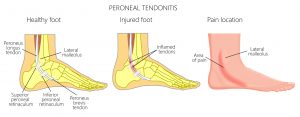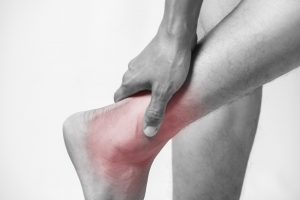
Runners expect a certain risk with their sport, such as all athletes do, and they know that there is a chance that they may end up as one of the many injured runners. You expect you might end up with runner’s knee or other common ailment, but sometimes the pain that you are experiencing doesn’t seem to fit any of the usual categories, and a search for similar injuries just doesn’t seem to come up with much. If so, you might have Peroneal Tendonitis.
One of the causes of pain on the outside of the ankle and foot is Peroneal Tendonitis. The main function of the peroneal tendons is to stabilize the foot and ankle and protect them from sprains. Runners who run along slopes, which causes rolling out of the foot, are more susceptible to Peroneal Tendonitis.
So you suspect you have Peroneal Tendonitis, now what?
Causes And Symptoms
Peroneal Tendonitis occurs when the tendons become inflamed. This can occur when there is overuse of the tendons, causing them to rub against the bone. The tendon is a band of tissue that attaches muscle to bone. There are two Peroneal Tendons that run on the outside of the lower leg. These tendons provide stability to the ankle and protect it from sprains.

Some of the common symptoms include: pain at the back of the ankle, pain that worsens with activity, pain when turning the foot, swelling at the back of the ankle, instability when bearing weight, and an area that is warm to the touch.
Diagnosis
It is important to determine that the pain is from the tendons and not the fibula. I will use a variety of techniques during a physical exam to look for symptoms. X-ray, ultrasound and MRI may also be used to diagnose if needed.
Home Treatment Options For Peroneal Tendonitis-Caused Pain
- Resting your foot as much as possible with it elevated to reduce ankle pressure is a good strategy
- Icing your ankle – you can use a freezer gel pack, or use a plastic bag with some ice wrapped in a cloth, then place it on your ankle. You may need to use medical tape or tie a cloth around the ice pack to keep it in position on the ankle
- Anti-inflammatory medications – this includes a topical analgesic gel like Biofreeze or oral pain relievers like Motrin, Advil or Aleve to bring down the swelling and reduce pain
- Using a Controlled Ankle Motion (CAM) boot or splint will help you keep your foot and ankle from moving and allow the injury to heal
- Once you feel well enough to return to your normal activities, when you run, run on a flat surface. This can help reduce the chance of re-injury
- You may need to change your shoe model. If you do change models, especially going from a neutral shoe to a motion control shoe (or vice versa), you will want a break-in period, as this will create different forces on your foot.
We have put together a home care stretching and exercise guide for dealing with Peroneal Tendonitis. Use this guide as a first step to help alleviate the pain.
Download a Free Copy of our Peroneal Tendonitis Stretching and Exercise Guide
Home treatment is not working? Now what? Perhaps it is time to consider more aggressive treatment in my office. I offer several treatment options to help you manage this condition.
In-Office Treatment Options
- Taping or strapping the foot. I can apply kinesio tape, such as Rocktape, to support and reduce painful symptoms
- Physical therapy is something I can write a prescription for if home stretches are not enough. Physical therapists offer rehabilitation exercises or other modalities to help the ankle to heal
- I also give steroid injections or prescribe stronger anti-inflammatory medication
- Podiatry recommended orthotics – insoles for peroneal tendon problems should place pressure beneath the lateral (outside) border of the sole of the foot and reduce pressure beneath the big toe joint. In essence, raising the outside border from the ground a little, which reduces the strain in the peroneal tendons
- Additional treatment options including surgery may even be discussed
When Can You Return To Running?
Avoiding running while injured is generally the best practice. The good news is this condition does not seem to be overly resistant to healing. So with the right rehab program and a bit of patience you should be back on the track soon!
If you have additional questions please let us know. You can call us or reach out through our contact page.